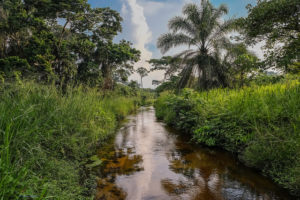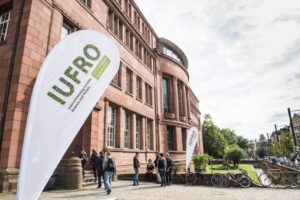
We can all agree that forests and trees play a vital role in sustaining life on earth. Addressing climate change – both mitigation and adaptation, something that few sectors can do simultaneously – ensuring food security and nutrition, and preserving biodiversity will not be possible without the full spectrum of solutions that forests, trees and agroforestry offer.
At the International Union of Forest Research Organizations (IUFRO) 125th Anniversary Congress, held on Sept. 18-22 in Freiburg, Germany, by one of the world’s oldest international scientific institutions, more than 40 scientists affiliated with the CGIAR Research Program on Forests, Trees and Agroforestry (FTA) presented their latest results and findings.
Among them were Bimbika Sijapati Basnett from the Center for International Forestry Research (CIFOR) and Marlène Elias from Bioversity International, who launched the Earthscan Reader on Gender and Forests, a major reference to ground future research, as well as to inform curricula worldwide.
FTA senior scientist Ramni Jamnadass of the World Agroforestry Centre (ICRAF) presented on safeguarding forest food tree diversity in a session on food trees in forests and farmlands, while her colleague Sonya Dewi presented about ICRAF’s work on combining remote sensing, crowdsourcing big data and multi-objective modelling to inform landscape approaches, during a session on forest restoration policy assessment in the tropics.
One of the major subplenary sessions – Changes in Forest Governance: Implications for Sustainable Forest Management – involved FTA scientists Pablo Pacheco and Paolo Cerutti of CIFOR, who presented on changes in forest governance in South America and Africa, respectively.
In a significant joint effort on the final day of the congress, IUFRO and FTA cohosted a subplenary session titled Research for sustainable development: Forests, trees and agroforestry, aimed at discussing main research and knowledge gaps in forest and tree science in relation to the sustainable development goals (SDGs), and how to address them.

Forest and trees are central to many of the challenges of our time. This raises new questions every day, as the IUFRO congress showcased. But this makes the prioritization of issues both more difficult and more necessary. What is needed most and where we should start? How should we, as researchers and research institutions, conduct research in order to best enable impact?
We faced the same issue when constructing the second phase of FTA, with a very long shortlist of 100 critical knowledge gaps and key research questions, from genetic resources to value chains and institutions.
I wonder if this centrality of forests and trees to so many challenges could not be an overarching guide to orient research prioritization. We need to fully embrace the fact that forest and tree research has to address a complex set of objectives, because forests and trees are not only concerned with SDG15 on life on land, but also with the 16 other goals. Integration is key. So the overarching issue might be how we can integrate the different dimensions of sustainable development and different objectives into the research questions, research methods and solutions we develop in practice.
For example, thanks to the integration of the work of very different scientific disciplines – tree biology, atmospheric biogeochemistry, climatology, hydrology and dendrology – there is now convincing convergent evidence on the role of forests in atmospheric water circulation, at continental scales. Forests enable rain to occur downwind at continental scales, and can help to preserve so-called bread baskets.
But we still need more work on the science base and, at the same time, on the types of institutions, policies and economic instruments to be developed so that action leads to outcomes for farmers in the field. This shows the need for integration between disciplines, scales and actors. In this particular domain, the Global Expert Panel on Forests and Water launched by IUFRO will be of tremendous use and I am particularly glad that it is being co-led by former FTA senior scientist Meine van Noordwijk, who recently retired but brought so much to FTA.
This question of the integration of objectives, of research domains and across scales, has important methodological implications, in terms of the solutions to be developed, how, with whom and for whom. It can, for a program as broad as FTA, lead to deciding to orient the priority support toward work that constructs linkages between research domains and system approaches.

There are two other critical dimensions to integrate:
First is the requirement to work on the full continuum from technical options to management, policy, governance and appropriate institutional arrangements. Looking at the enabling environment, such as institutional arrangements, incentive schemes and adapted business models, will facilitate upscaling and outscaling of technical options.
Second is the need to work on the “research for development” continuum, from upstream research to how the actors use this, and integrating stakeholders from the framing of questions to the development and implementation of solutions.
This implies, as spearheaded by Brian Belcher, FTA’s monitoring, evaluation and learning and impact assessment head, the need to revisit what we mean by “quality of research”, enlarging it to four dimensions. The traditional dimensions of relevance and scientific credibility need to be completed by legitimacy and effectiveness.
- Legitimacy means that the research process is fair and ethical, and perceived as such, with consideration of the interests and perspectives of the intended users.
- Effectiveness means that research has high potential to contribute to innovations and solutions. It implies that research is designed, implemented and positioned for use, which implies work along what we call a “theory of change”.
We can complement CGIAR by embracing this framework to define and measure the quality of research for development. This requires building appropriate partnerships, starting with development actors, and working on the enabling environment to translate knowledge to use. In FTA, for a substantial part of our research, we embed research in development projects. We aim at doing research “in” development, rather than research “for” development.
To enable this, FTA aims at playing the role of a boundary institution:
- To understand the frontiers of science, working with universities, research institutions
- To understand the need of beneficiaries, working with local stakeholders, governments
- To understand the priorities of funders
- To organize the dialogue between the three, and provide packages that bring them all together
This is a good reason why, in the future, we at FTA would like to further strengthen our relations with IUFRO.
By Vincent Gitz, FTA Director











